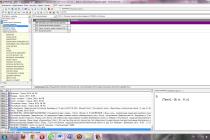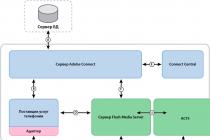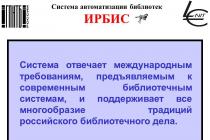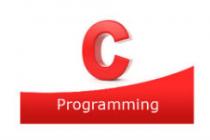Are you looking for a high-paying job that is enjoyable? According to Harvard Business Review magazine, the sexiest profession of the 21st century is the data scientist.
This concept was coined by Jeffrey Hammerbacher and Dr. Patil, not wanting to call big data employees business analysts or research scientists. Since then, the term has gained immense popularity.
Information analysts are curious people who know how to identify trends based on data. They do not just sift and structure data for the client company, but are part of a cross-functional team, providing various departments of the company with the information necessary to optimize the workflow and introduce innovations.
Well, let's take a look at what qualities and skills an information analyst should have.
IT technologies
An information analyst, of course, should be on the "you" with open software platforms and tools like Hadoop, Java, Python, C ++, ECL, etc. In addition, you need to have an understanding of NoSQL, HBase, CouchDB databases.
Maths
An information analyst needs knowledge of statistics, data analysis algorithms, and machine learning and mathematics. For a true information analyst, conventional computer science is a long-passed level in an IT quest. So an expert in this area is far from an ordinary computer scientist. On the one hand, he is an expert in the field of large-scale machine learning, on the other hand, he is a statistician.
Business
Among other things, an information analyst needs to have business skills. He must communicate with different people in the organization, understand business requirements, be able to interpret patterns, see relationships, communicate information correctly, interact with developers and company leaders. All this requires real business skills.
Visualization
An important skill for an information analyst is the ability to focus on real products and make data available to users. In other words, the information analyst needs to see when and how data can drive a company's bottom line. Then it is important to visualize the information. You also need to be proficient with data visualization tools - Tableau, Flare, D3.js, refactoring, Google Visualization API, and Raphael.js.
Innovations
An information analyst doesn't just know how to work with large amounts of information. This is a real enthusiast - a creative person striving to learn new things.
Problem solving. Such a skill may seem very obvious, however, it should be emphasized once again that the information analyst should not only make every effort to solve the assigned tasks, but also carefully consider what benefits the result of his work will bring, by whom and how it will be used.
Communication
Communication skills are key to working effectively with other members of a cross-functional team, as well as with management and clients. In other words, if you are a hundred times an expert in all of the above areas, without the ability to find a common language with people, you will never become a good information analyst.
We live in a world where data flows in huge volumes and at a tremendous speed - from social networks and online stores to sensors in laboratories and smart meters. In order to systematize this data and extract the maximum benefit from it, the world needs specialists in its processing. So if you have all of the above knowledge and skills, go for it!
Translation by Larisa Shuriga
Consider IAD as process semantic data processing, as a result of which disparate data turns into a complete information product. The meaning of this is especially necessary in modern conditions activity - IAD is revealed through understanding the concepts of "informational" and "analytical". Let us turn to the etymology of the word "analysis". Usually the term "analysis" is considered in certain contexts. On the one hand, analysis is the mental division of an object into which allows you to get an idea of the structure of the object under study, its structure, parts, as opposed to synthesis; according to another point of view, analysis also includes synthesis procedures, in this regard, analysis is identified with activity.
The concept of "information" means the attitude to information as a resource, the possession of the entire arsenal of means of obtaining, accumulating, storing, processing and issuing information to the consumer. In the XX century, analytical activity became widespread and turned into a professional activity. In many countries there are "Factories of thought", information and analytical departments and services in government agencies, companies, banks, political parties. Rapidly developing markets for analytical information, intellectual product, methodological and software.
The formation of information analytics as a special area of activity (IAD) took place in the shortest possible time, in an atmosphere of maximum intensification of all processes and the exacerbation of many problems. Despite the fact that analytical activity has been used for a long time, its classification and precise definition have not yet developed. H.A. Slyadneva, Doctor of Pedagogy, Professor (Moscow) gives the following definition: "Information analytics is engaged in the production of new knowledge based on the processing of existing information in order to optimize decision-making. Modern information analytics is a complex complex activity that relies on both natural intelligence, and on computer technologies for operating information arrays, methods of mathematical modeling of processes, etc. " ... Information analytics performs primarily the task of qualitatively meaningful transformation of information, functionally intersecting in this regard with scientific (production of new knowledge) and management (development of solutions, scenarios) activities. The nature of the functional intersection (interaction) in the "analytics-science" system can be defined as follows: on the one hand, science and information analytics are informational methods of cognition and scientific analysis of reality; however, there is a difference between them - information analytics, relying on scientific knowledge, general laws, most often deals with the phenomenology of being, assessing facts and events, predicting their development, taking into account not only generalized typical parameters, but also a number of additional factors ( subjective-personal, random, etc.), science first of all reveals the fundamental, objective laws of the investigated area, repeats the essential connections of objects, generalized parameters of processes, etc.
We will provide a description of the process of information and analytical activities. The process of information and analytical work is a set of thinking operations and technological procedures aimed at a certain subject, the implementation of which in a certain sequence with the use of means ensures the solution of the task.
IAD process consists of the following components:
o Organizational;
o Methodical;
o Informational;
o Communication;
o Formation of conclusions and proposals. The stages (stages) of the IAD process are:
1) general acquaintance with the problem, problem statement
2) the formation of concepts, their definitions
3) collecting facts, creating a database
4) interpretation of facts
5) hypothesis formation, hypothesis testing
6) forming conclusions
7) direct presentation of materials
From the point of view of D.I. Pushkash, information and analytical activity (IAD) is a process of semantic data processing, as a result of which disparate data turns into a complete information product - an analytical document. The process of semantic data processing can be represented in the form of a certain sequence of independent stages, the aggregate description of which gives an idea of it as a whole. Below is one of the possible schemes for organizing the IAD process, presented in the form of an algorithmic sequence of procedures:
1. IAD begins definition of the object, subject and problem of analysis. This stage includes familiarization with the problem as a whole, as well as with related issues, the study of which may be useful; drawing up a general work plan with an indication of the deadline, executors and main sources that can probably be used.
2. Building an ideal model of an object and an object - next step. Provides the creation of a regulatory framework for further analytical activities.
3. Collection of factual data. This is an obligatory stage of the IAD, regardless of the field of study and the phenomenon under study. First of all, it is necessary to clearly define the concepts used and the largest possible source base. When selecting sources, it is necessary to be critical of the information found.
Rice. 5.in
4. Assessment of factual material. The main task at this stage is to evaluate the data obtained, to select from the mass of the described facts those, the analysis of which is advisable to continue. This stage includes assessment, classification, analysis and fact-finding.
5. Disclosure of the meaning of facts. Attention is drawn to the fact that a fact carries a large semantic load if it is considered in conjunction with other facts or additionally indicates its meaning, therefore, it is necessary in every possible way to achieve the most complete disclosure of the meaning of each fact.
6. Hypothesis. At this stage, it is necessary to construct a hypothesis about the relationship between separate, at first glance, facts. Putting a hypothesis makes it easier to clarify the problem. The comprehension of hypotheses is of a research nature. The subject "imposes" on the hypothesis the prism of his ideas, conditioned by personal experience and knowledge of the subject area. Hypothesis building is inherent in any analytical work. In the beginning, some assumptions (hypotheses) are made about what factors may play important role, and which are irrelevant. Similar hypotheses are used when collecting and interpreting facts, formulating conclusions and calculations.
7. At this stage, you have to choose the type of analysis.
8. The selected type of analysis predetermines the choice specific methods analytical activities, of which there are a huge number.
9. Proof. At this stage, it is necessary to prove or disprove the validity of the working hypotheses.
10. Conclusions. Here the final conclusions are formulated, which is the goal of any information analysis.
11. Reliable and understandable presentation of research results. Drawing up the document, completes the work. It is necessary to ensure that the final document is written in a language that is accessible to the consumer of information products. If necessary, to achieve maximum effect, you can use tables and diagrams, multimedia presentations.
Possession of the described algorithm for semantic data processing is a prerequisite for the success of activities in many industries. Skeptics argue that "analytics is a profession that is based on esoteric knowledge and intuition, on the mystery of penetrating the hidden mechanisms of politics, economics, etc., on the artificial endowments of its representatives capable of intellectual magic." There are objective grounds for this position. Analytics is heuristic in nature, so it is quite difficult to understand the intellectual technologies of analytical activity, identify its techniques and implement them in the training of future specialists. On the other hand, analytics
This is an activity that involves the organic synthesis of three components: possession of analytical methods (functional component), knowledge of the subject area (industry component) and a certain type of personality structure (special component). The same structure is typical for research, artistic and creative, teaching, management and other activities.
It is known that analysis and synthesis are the main methods of thinking. Analysis (Greek analysis - decomposition, dismemberment) and synthesis (Greek synthesis
Connection, combination, composition) are the processes of mentally dismembering the whole into its component parts and reuniting the whole from the parts. Information analysis is the initial stage in the transformation of documentary information, which consists in studying documents and extracting the most essential information from them. This process is inseparable from synthesis, i.e. generalization of information obtained as a result of information analysis of documents and preparation of the results of generalization in one form or another. Analytical and synthetic processing is a set of processes for transforming the content of documents with the aim of analyzing them, extracting the necessary information, as well as evaluating, comparing and generalizing. In the process of analytical and synthetic processing, information is curtailed, the task of which is to provide a meaningful assessment of the social significance of the document (its scientific, cultural value) and to reduce the physical volume, provided minimum loss informativeness.
Analytical and synthetic processing of a document is called its transformation in order to obtain necessary information, as well as assessment, comparison, generalization and presentation of the information received in the form that corresponds to the request. If the purpose of working with scientific documents is their systematization, analysis and synthesis, which does not reach the acquisition of new knowledge, then such activity refers to scientific information. If the purpose of working with scientific documents is to gain new knowledge about the subject that is being studied, then such activity belongs to scientific research.
It is important to emphasize that analytical and synthetic processing of information takes place not only in scientific information activities(NID), but also in other types of cognition. What, then, determines the specifics of the NID? In order to answer this question, one can compare NID with such types of knowledge as research activities, on the one hand, and scientific and technical intelligence, on the other.
The purpose of research activities and analytical and synthetic processing of information is to extract from documents new facts or information that are not explicitly expressed in these documents. New information is logically deduced from the available information, and for this, the so-called extralinguistic information is additionally used (i.e. information that is not contained in these documents). Activity is built in the same way, it is called scientific and technical intelligence. It is known that in peacetime at least 80% of intelligence information is obtained by means of analytical and synthetic processing of information extracted from unclassified sources - newspapers, magazines, books, television and radio broadcasts, materials of the World Wide Web, etc. The task of a specialist analyst in this case is removal from the text of one or several documents of such information (partly classified), which are not explicitly contained in these documents.
Regarding the specifics of analytical and synthetic processing of information under NID, it consists in grouping, comparing, evaluating and generalizing that and only that information that is clearly in these documents, as well as in presenting generalized information in a compact form convenient for its practical use. In information analysis and synthesis in the course of NID, extralinguistic information is not used (of course, to the extent that it is generally possible with the intellectual activity of people).
The processes of analytical and synthetic processing include such processes as: bibliographic description; annotation; systematization; subjecting; referencing; indexing; scientific translation; preparation of reviews; extract from documents of facts.
Let's give a definition of the main processes of analytical and synthetic processing of documents:
o Bibliographic description - the process of standardized presentation of basic data about a document;
o Annotation - the process of compiling brief information that characterizes a document in terms of its content, focus, value, purpose, design and origin (annotation answers the question: What does the document say?);
o Referencing - the process of writing an abstract, which is a summary of the content of the document, research methods and results, as well as the time and place of research (the abstract answers the question: What does the document contain?);
o Drafting an overview - the process of collapsing information about multiple documents; in other words, we can say that the reviews summarize the information contained in different documents... There are three types of reviews: Bibliographic; abstract (characterized by a great depth of generalization); analytical (the result of an analysis of documentary sources and an assessment; a certain interpretation of the facts extracted from them; they, in turn, are subdivided into final, prognostic, justification reviews);
o Indexing is the process of describing the content and form of a document by means of an artificial information retrieval language (that is, the choice keywords and translation into IPM (information retrieval language) or replacing them with the corresponding lexical units (indices));
o Scientific translation is the translation of texts (scientific, technical, economic, etc.) from one language to another;
o Fact extraction from documents are facts such as specifications, properties of substances and materials, demographic characteristics, etc.
No matter how the information and analytical work is organized, the first and therefore extremely important procedure is the primary analysis (express analysis) and the selection of relevant information. This procedure serves as a kind of filter that discards the unnecessary and protects the analyst from information noise (redundancy). The meaning of this procedure is, first of all, in establishing the essence, importance, accuracy, completeness and significance of information on the basis of its division (fragmentation) and comparison. Let us explain the meaning of these concepts.
The essence of information consists in the totality of the features of objects, systems, phenomena and processes reflected in it, isolated from a more significant volume. Information always reflects the degree of change in existing knowledge.
The importance of information. Information is important if it is relevant, that is, it has a connection with the solution of the problem, and if its use can contribute to the activity (current or planned).
Reliability of information. It is not always easy to establish whether information is true or false, especially if it contains information about events that have not yet occurred. There are criteria by which one can judge the reliability of information, namely:
Reasonableness criterion (availability of confirmation of the information received in a number of independent sources);
Consistency criterion: the absence of contradictions between the individual statements set out in the notification; the absence of contradictions within the group of messages that came from one and / or a group of sources for a certain period of time;
Thus, IAD is as a process that, in turn, covers certain processes of both analytical and informational activities; contains its own specific stages and procedures that need to be mastered by specialists - information analysts.
Society at the present stage of development is experiencing information revolution caused by the increasing role of information in all its spheres, which leads to a revision of the basic concept of "information" and filling it with new meanings. The informatization of society is reflected in all spheres of human life, including education.
In a modern educational institution (OU) that carries out personality-oriented and developmental learning, its monitoring and diagnostics, the flow of information between participants and organizers of the educational process increases many times over. In this regard, the pedagogical staff, and especially the administration of the educational institution, are faced with the question of using modern technologies for processing, storing and analyzing the information received.
Informatization of educational institutions has two directions:
Implementation information technologies directly into the learning process;
Informatization of the OS control system.
Within the framework of the first direction, the urgent tasks today are:
1.improvement and filling information space schools teaching information material, as didactic tools for modeling various educational objects and processes, increasing the degree of visibility in the presentation of educational material, conducting laboratory and practical work;
2. systematization and logical ordering of the content of education, training and control of knowledge;
3.processing of existing educational and methodological material into electronic form and creation information bases data;
4. organization of work of electives, circles, conducting computer Olympiads, contests, festivals.
Informatization of the educational management system of an educational institution implies the introduction of information technologies associated with the processes of collecting and analyzing information for educational, educational, methodological, as well as administrative and economic activities, planning and organizing office work, which will allow a systematic approach to the management of educational institutions.
The use of modern technologies for processing, storing and analyzing the information received will provide:
Structured information;
Automation of document flow in terms of analytical references, reports;
Accumulation and constant updating of information necessary for solving the problems of the process of teaching, upbringing and management.
Consequently, in a modern educational institution, a specialist is needed who is trained to solve the following professional tasks:
1.the introduction of informatics methods in the subject areas of pedagogy;
2.capacity development and adaptation information systems at all stages of their life cycle:
2.1 creation of information-logical models of objects, development of new software and information support to support the educational process and management of educational institutions,
2.2 docking of information systems from different subject areas in connection with emerging new tasks, transfer of systems to new hardware and information platforms;
3. optimization of information processes of information processing;
4. reducing the psychological barrier between the employees of the educational institution and the specialists of the informatization service.
The social order of society is reflected in the regulatory documents of the Ministry of Education and Science of the Russian Federation (Federal Program for the Development of Education (2000); Federal Target Programs "Development of a Unified Educational Information Environment" (2001-2005); Concept for the modernization of Russian education for the period up to 2010; as well as the State educational standard of higher vocational education(specialty 351400 - Applied Informatics (in education)), which emphasizes the social significance of informatization of educational institutions at all levels.
In accordance with the standard, graduates of this specialty are engaged in the creation, implementation, analysis and maintenance of professionally oriented information systems in education; are professionals in the application of information systems and the management of information flows in them.
These qualities require professional training both in the field of informatics and information systems, and in the field of application, i.e. education. Thus, a graduate - computer scientist (with a qualification in the field of education) in his practical activity analyzes, predicts, models and creates information processes and technologies within professionally oriented information systems. The main types of professional activity of informatics in education are organizational and managerial, design and technological, marketing, experimental research, consulting, analytical, and operational activities. Figure 1 shows the departments of the educational institution, where it is necessary professional activity a specialist in this field.
A certified specialist "Informatics analyst in the field of education", possessing the skills of developing, implementing and supporting information systems, as well as having appropriate professional training in the field of education, will be in demand both directly in the educational institution and in the department of education and in the field of additional education
Literature
1. Grinberg A.S., Gorbachev N.N., Bondarenko A.S. Information technology management. Publishing house: Alpina Business Books, 2004
2. Belkin V. Yu., Kostenko KI, Kurgan AB, Levitskiy BE Technologies for the formation of documentary information environments in various fields of knowledge // Tr. Vseros. scientific method. conf. "Telematics" 2002 ", June 3-6, 2002, St. Petersburg. SPb., 2002. p. 86-88.
3. Robert I.V. Theory and methodology of informatization of education (psychological, pedagogical and technological aspects). IO RAO. M .: - 2007, 18. p.p.
4. GOST RF Specialty 351400 "Applied Informatics (by regions)". http://www.math.spbu.ru/ru/mmeh/Gost/351400.html
Systems Analyst Is a specialist in the field of domain analysis and formulation of requirements for the information systems and applied software being developed. The profession is suitable for those who are interested in computer science (see the choice of profession by interest in school subjects).
The main product of systems analytics is organizational and technical solutions, drawn up as a technical task for software... All his work is based on the system analysis technique, and the result should be the stable operation of the equipment and the satisfaction of its technical properties to the customer's requests.
The systems analyst must balance on the line between the business of the enterprise and the capabilities of the IT department, he must imagine the entire project as a whole, therefore, his responsibility is to create a structure for interaction between the two companies.
The key role of a systems analyst in a company automation project is to develop a consistent and complete model of business requirements for the software being deployed. First, the systems analyst collects the requirements for a new software product, after which he develops the terms of reference for the creation of software, designs the documentation of the system and software architectures of the IT system, sets the tasks for development and testing. At the end of the project, he explains the rules of work to users and solves the problems of functioning at all stages of the life cycle of the created system.
Features of the profession
Typical responsibilities of a systems analyst:
- study of a particular area for the implementation and development of applied information systems;
- participation in interviewing business experts and users of information systems in order to study the current principles of organizing business processes;
- study and systematization of project documentation in terms of identifying processes to be automated;
- preparation of documentation for the description of entities, relationships and processes of the subject area using special notations;
- participation in the setting of tasks and the development of technical specifications;
- collection, analysis and documentation of functional requirements for software.
- participation in the preparation of functional testing schemes to identify deviations from the formulated business requirements and functional requirements;
- participation in testing the prototype of the system being developed;
- participation in training system users;
- analysis of risks and causes of errors in the development of systems;
- participation in choosing a platform for project implementation.
Pros and cons of the profession
Pros:
- high demand in the labor market;
- a fairly high level of remuneration;
- flexible work schedule, including the ability to work remotely;
- the indisputable importance of a system analyst in the eyes of employees and customers, satisfaction from the implemented project,
- the ability to travel around the country and abroad;
- the opportunity to realize your creative abilities;
- the result of the work and tangible benefits are visible immediately, as soon as the work process in the company is brought to a new level;
- due to the skills of communicative communication during projects in different organizations, the circle of useful acquaintances is expanding.
Minuses:
- disagreements, disputes with the client as a result of his misunderstanding of the difference between one system and another and, in addition, the low efficiency of his task;
- often users have a negative attitude to the implementation of a new information system in a company, then the analyst has to patiently and persistently explain its benefits and advantages, which takes time and nerves;
- due to high level adjacency with other specializations (developer, application architect, consultant) there is a risk of switching the system analyst to related tasks, which may not always meet the goals and aspirations of the specialist;
- irregular working hours, frequent business trips (although such trips have their advantages: foreign companies like to conduct internships for employees of representative offices - a great chance at their expense to live in a luxury hotel, see other countries. Civilized companies organize not only training, but also recreation, in the program which includes classes, visits to exhibitions, excursions).
Place of work
Large banks, consulting companies specializing in the development of IT solutions for external customers.
Important qualities
A systems analyst should have such qualities as systems thinking, an analytical mindset, sociability, persistence, the ability to formulate consistent requirements, separate the general and the particular, pay more attention to essential details and ignore the insignificant. Intuition, a long-term vision of the development of processes and systems, and the ability to “read between the lines” are extremely important.
The key skills for a systems analyst are:
- the ability to quickly understand the requirements and determine their priority, as well as talk about technical solutions and their impact on the business in a language understandable to the client;
- the ability to follow the accepted methodology, notations and forms of documents in various projects;
- skills in working with the relevant software;
- the ability to work collaboratively with other analysts if a team is working on a project;
- the ability, while maintaining a creative style of work, to maintain discipline with respect to maintaining documents, versions, protocols and a willingness to work in a team with architects, developers, testers;
- the skill to convincingly demonstrate the company's competence in a certain area, based on the results of a short conversation, to get an idea of the client and his requirements for a solution.
A systems analyst should know:
- fundamentals of programming (including object-oriented), design, development, software documentation;
- fundamentals of the theory of algorithms, theory of databases, theory of systems and systems analysis, fundamentals of information security;
- basics of designing human-machine interfaces;
- have general knowledge in the field of management, fundamentals of economics, accounting and management accounting.
Systems analyst training
Universities
It should be added that more often than others in the vacancies of system analysts there are requirements for knowledge of the following software: MS Visio, All Fusion, ARIS, Rational Suite, IDEF, DFD, UML standards and the SQL language.
Salary
Salary as of 01/29/2020
Russia 40,000—150,000 ₽
Moscow 60000—240000 ₽
The amount of income of a system analyst with work experience, first of all, depends on the direction of the company and the level of projects and tasks. In development companies, as a rule, material compensation depends on the volume of work and services performed (salary + interest on the cost of services). In the customer's companies - a fixed salary plus bonuses in accordance with the adopted incentive system. Bonuses are usually awarded based on the results of participation and completion of projects.
Career Steps and Prospects
If a systems analyst got a job in a representative office of a large Western or even a domestic company, then consider that his career has already taken place. Among the prospects - promotion in the department, as well as within the company itself. Having experience as a systems analyst and experience in participating in projects, a specialist can continue his professional development and apply for positions: application architect, consultant for the implementation of information systems, project manager for implementation.
What is the difference between a systems analyst and a business analyst?
From a theoretical point of view, the system is a more comprehensive concept than business. That is, a systems analyst analyzes everything, while a business analyst only analyzes those related to business issues. On the other hand, the first is traditionally related to the field of information technology (IT), that is, its improvements relate only to the introduction of new IT developments, and the second is improved by any methods, including IT methods. From this point of view, the concept of “business analyst activity” is broader than “the competence of a systems analyst”. But in practice, any analysis as a result comes down to the fact that the work needs to be improved, which is possible, as a rule, due to the automation of processes. This is how the responsibilities of these two specialists merge into one whole. Note that specialized IT companies require a system analyst, and non-core IT companies require a business analyst.
There are situations when, for example, in some company A there is a business analyst, his activity leads to the fact that company A applies for software product to company B. In the latter, if it develops and implements software, there is a systems analyst. In this case, the business analyst of company A works hand in hand with the systems analyst of company B.














